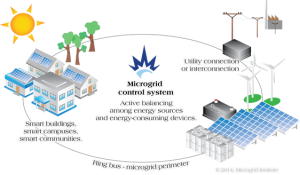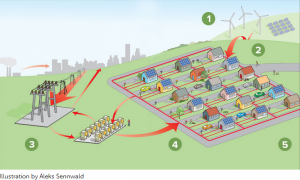Microgrids are a relatively new term. It’s been popping up in articles since 2010, but the term hasn’t hit the mainstream public. Until now. During President Obama’s keynote speech at the Clean Energy Summit on Monday, he mentioned microgrids, but didn’t go into much detail behind them. What are they, what do they do, and what benefits do they bring? While microgrids are still a major topic of discussion, and many components of them still aren’t 100% clear, this article hopes to shed some more light on these questions.
The Traditional, Aging Power Grid
For the past century and more, the United States has been a pioneer in science, technology, infrastructure, and other human advancements. The Edison Illuminating Company, championed by Thomas Edison, built the first commercial power plant—Pearl Street Station—in 1882. Since then, we have come a long way, but our infrastructure hasn’t seen many significant upgrades since its construction over 50 years ago. According to the International Business Times, “The United States endures more blackouts than any other developed nation.” What’s more, “. . . the U.S. electric grid loses power 285 percent more often than in 1984 . . . . That’s costing American businesses as much as $150 billion per year.” Microgrids are a new attempt to solve the problems of the aging infrastructure of the traditional power grid system.
What are Microgrids?

To put it simply, your home and business is powered by the utility’s power grid—a macrogrid. A microgrid is, essentially, a smaller grid that can operate autonomously or in conjunction with your utility’s macrogrid. Instead of serving an entire city, microgrids can support single users, areas only consisting of a few houses, and even areas that cover large universities. Microgrids operate and consist of the same mechanics of the main power grid: power generation, distribution, and controls.
One of the best detailed descriptions of microgrids comes from David Ferris at Forbes:
“It is a system that blends power from the utilities with local power whether there is an outage or not . . . . It reduces emissions by scaling down the power arriving from faraway, carbon-spewing coal or natural-gas plants, while adding in local sources like fuel cells, biomass plants, and solar and wind power installations. It prioritizes power needs so that during a blackout, the most crucial elements stay on (like data centers) while less important ones (like coat closets) are let go. It gives a user some control over the power supply instead of just begging to the power company. And it does all this autonomously without a flicker in the lights.”
Other great explanations of potential applications of microgrids come from Sierra Magazine:

Microgrids would make feasible large community energy projects such as biomass plants, banks of fuel cells, and neighborhood arrays of solar panels or wind turbines.
When a blackout occurs, rooftop solar panels often go dead too, since most people have no way to store electricity on-site. A microgrid might enable the panels to keep working. But the really interesting question is where that power would go. Would you use it yourself or dedicate your trickle of power to the police station?
Conventional electricity is delivered through a tangled network of substations and feeders. Microgrids could use smart inverters–newer, more adaptive tools for converting between DC and AC power–and sophisticated software to allow a community to deliver and retrieve power without disturbing the grid’s delicate voltage balance.
Microgrids could make the power system more efficient (by preserving the up to 15 percent of electricity that can be lost on long-distance transmission lines and local feeders) and less polluting (by reducing reliance on carbon dioxide-spewing power plants).
For the local microgrid to provide serious backup during a power outage, there would have to be storage. That could take the form of clean fuel or large, expensive batteries–or even those batteries-on-wheels otherwise known as electric cars. This so-called vehicle-to-grid solution could serve as a giant, flexible, and networked storehouse of energy for the neighborhood.
The Microgrid Solution
With these notes in mind, experts believe microgrids have distinct advantages over the traditional grid structure, including:
- Improved energy efficiency
- Minimization of overall energy consumption
- Reduced environmental impact
- Improvement of reliability of supply
- Network operational benefits
- Loss reduction
- Congestion relief
- Voltage control
- Security of supply
- More cost efficient electricity infrastructure replacement
Major Applications
Right now, microgrids are being tested on a large scale at some major universities, including the University of Chicago under the Galvin Center project, and the University of California San Diego (UCSD). Both institutions have some very informative videos about microgrids and smart grid systems.
The Galvin Center’s 8-minute video introduction to smart grids
How UCSD uses microgrids on campus
Final Thoughts
Microgrids are still a relatively new concept. They are still being tested and studied on the large scale. As such, we are a ways away from seeing microgrids work in conjunction with the main power grid to power and heat our homes and businesses. There are still many questions left that remained to be answered. Yet, the smart grid promises to revolutionize the way we work with and use our energy.




